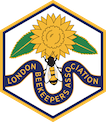
|
London Beekeepers' Association |

|
London Beekeepers' Association |
Oct in the Apiary[In the apiary, month by month.] Howard Nichols Feeding syrup to the bees should have been completed by the end of September as the colony will now start to find it difficult to process and cap the syrup due to the colder temperature. If left uncapped then there is the risk of fermentation and subsequent dysentery within the colony over the winter months. A colony should go into winter with at least 15kg (35lb) of stores if possible. This will avoid the possibility of the bees dying of starvation in a cold spring or the necessity for the beekeeper to feed in spring. Due to the warmer winters the bees are flying more and clustering less during winter. Brood is usually present throughout winter which requires more heat to be released and so more stores being consumed. It is far better to ensure a full supply of winter stores in Autumn rather than having to feed candy in winter or syrup in spring, both of which, in turn, create additional problems. The bees will now start to cluster as temperatures fall. Clustering starts at about 18°C, albeit very loose, and the cluster becomes smaller and more compact as temperatures continue to fall. They form a complete cluster at 13°C. Other than this the colony will continue to operate as usual but on a much smaller scale. The queen will still be laying a few eggs, nurse bees nurturing a smaller amount of brood and bees should still be flying in the day throughout October. Bees should be foraging on Ivy, which is the last flowering plant of the year. If Apiguard was diligently applied in August and a feeding programme undertaken in September then the colony should be in optimum condition to face the harshness of the next few months. This leaves the beekeeper to make final sundry preparations for winter. The objective for October is to put the bees in the best position to deal with winter by trying to do small things to tip the scales in their favour. Check that hives are secure, straight and stable. If using a wooden floor then the colony should be slightly tilted slightly forward. Bees have evolved over millions of years to deal with cold temperatures and do this with relative ease. They cannot deal with damp and condensation. During winter they need to uncap and metabolise honey to keep warm, resulting in production of water vapour. If the hive is not adequately ventilated then dampness may build up leading to fungal growth. It is essential that the hive interior remains dry throughout the winter. This is another advantage of using an open mesh floor. Mouseguards. Once the night frosts commence then mice will look for a dark, warm place to hibernate. The smell and disturbance will upset the bees and, in more extreme instances, the colony can die out. Use of a mouseguard is essential as it is extremely effective but there must be no way the mice can bypass it. Gardening measures. Check there are no branches grown up over summer and now overhanging the hive. If so then prune to remove. Also check that grass and weeds have not grown up around the hive as these will both reduce ventilation and promote damp. A quick trim with a strimmer or garden shears should be sufficient for the winter. Other jobs. Make sure that spare brood and super boxes are cleaned and put away in a cold place for the winter to deter wax moth. Placing combs in a deep freeze for 24 hours if possible kills all 4 stages of wax moth. The bees put a lot of work and resources into making the comb. The beekeeper, as custodian over the winter months, has a duty of care to look after this valuable resource until returned to its rightful owners in the spring! Other equipment such as queen excluders, crownboards should also be cleaned and stored the same way. Finally, October is the month for the National Honey Show held at Sandown Racecourse (Esher, Surrey, KT10 9AJ). |
©2025 London Beekeepers' Association |